Casoncelli pasta, also called casonsei, is a classic stuffed pasta from Eastern Lombardy, Italy. There are a number of versions of this delicious traditional dish. This particular recipe is for casoncelli della Valcamonica, a valley in the Italian Alps. It’s a fabulous authentic Italian pasta recipe for those who enjoy making homemade pasta from scratch!
History of casoncelli pasta.
Casoncelli, also called casonsèi in the local dialect, is a typical stuffed pasta from Lombardy, particularly the provinces of Bergamo and Brescia. This pasta is thought to be very ancient, even older than the more famous tortellini and classic ravioli.
In fact, there are references to casconcelli pasta in manuscripts dating back to the second half of the 1300s! Consequently, some food historians believe that stuffed pasta may have originated in Eastern Lombardy.
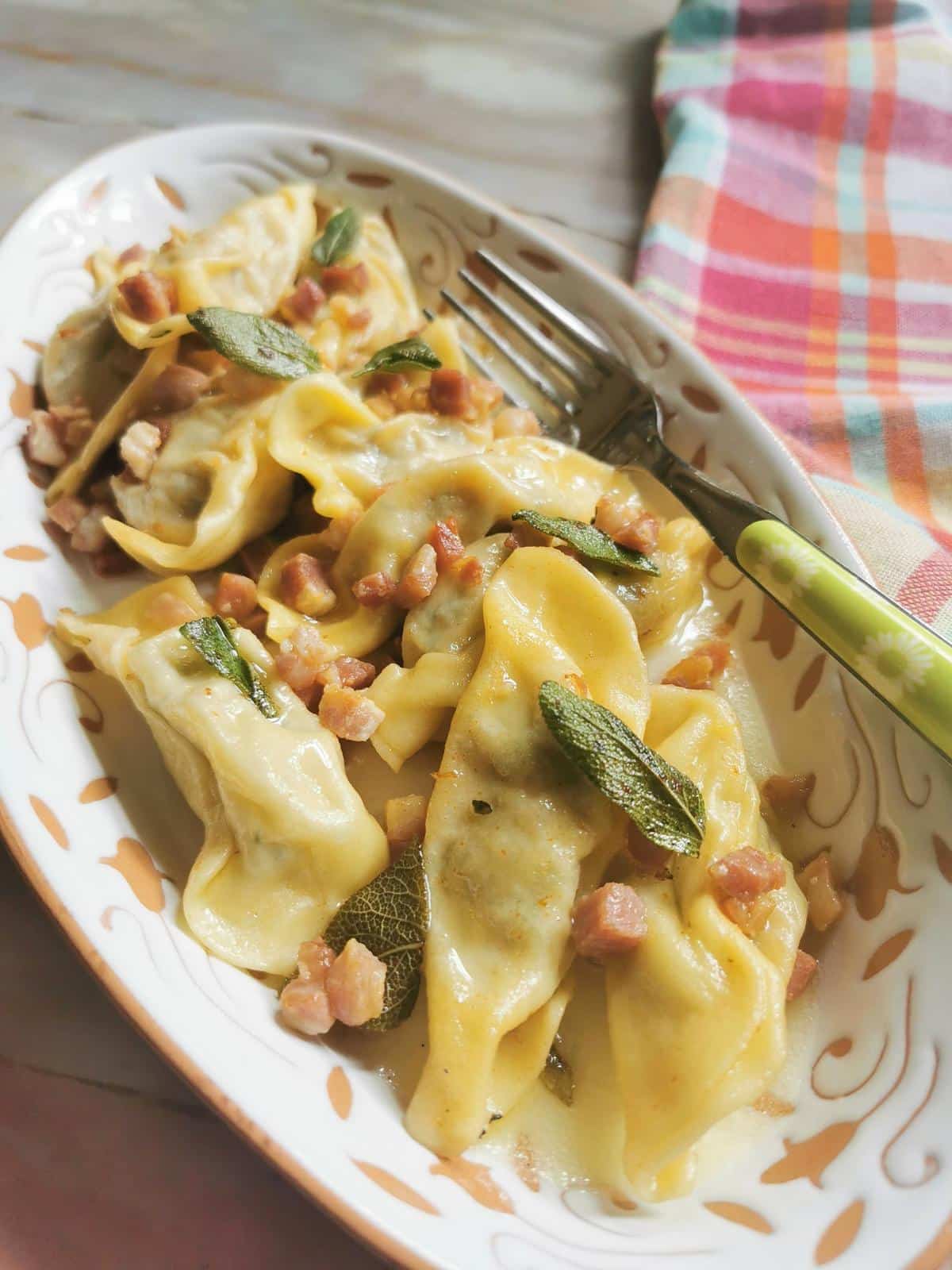
There are a number of different types of casoncelli or casonsèi; some are quite rustic and filled with mostly simple ingredients easily available to the poorer rural population in the past. This type of stuffed pasta was possibly created with the aim of avoiding waste and consuming what could not and should not be thrown away.
Then, there are casconcelli with a more ‘expensive’ filling including various cooked meats and fat, along with raisins, sultanas, pears, candied citrus fruit, Marsala and amaretti biscuits! These versions of this pasta were originally more commonly enjoyed by noble families.
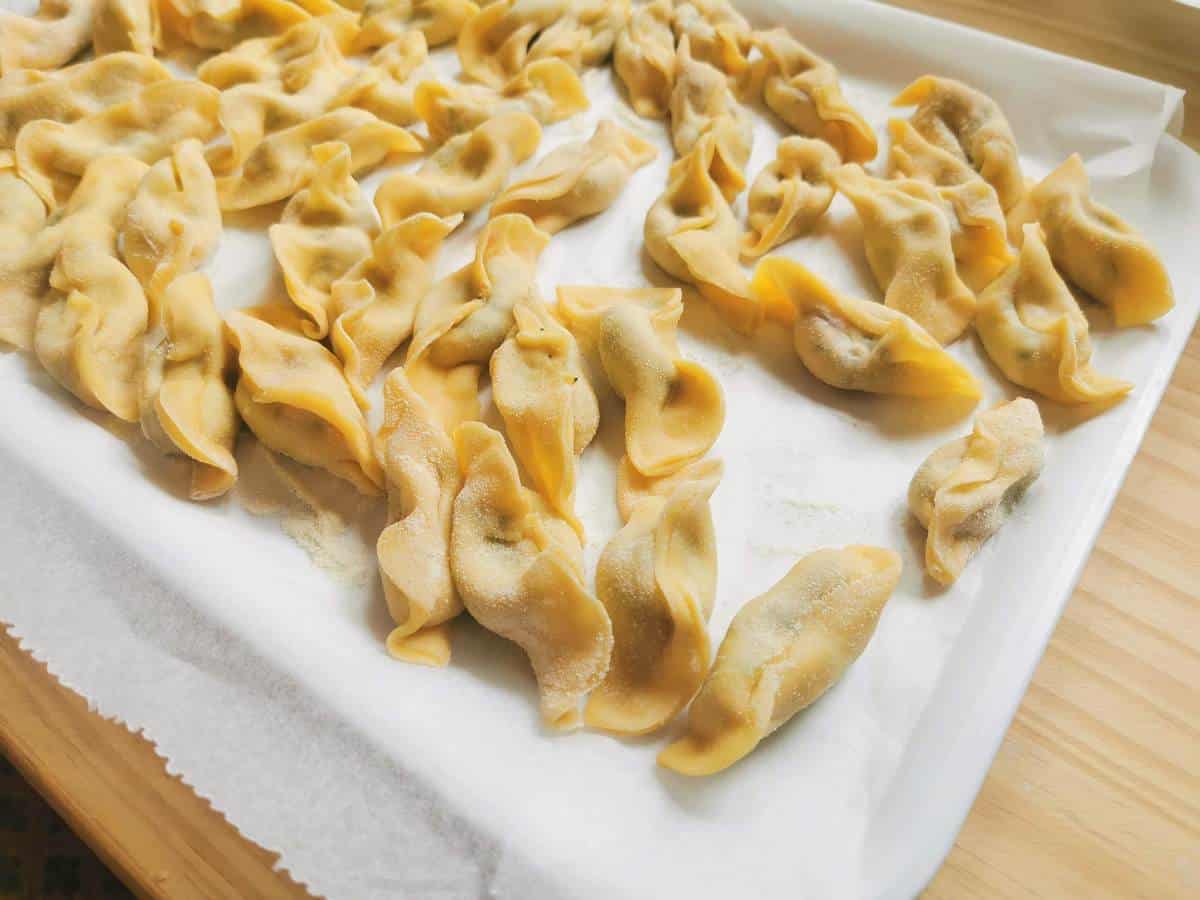
Casoncelli della Valcamonica.
Today, you can still find different types of casoncelli pasta, although some of the original ingredients such as lard and beef marrow, candied citrus fruit and Marsala are rarely included. There are also variations in the shape of the pasta and the ingredients in the dough.
This casoncelli recipe comes from the Valcamonica (Camoinca valley), one of the largest valleys in the Italian Alps. This valley lies in the Brescia province. It goes from the top of Lake Iseo to the Tonale Pass, a high mountain pass 1,883 m (6,178 ft) above sea level which runs from Lombardy to Trentino.

Casoncelli from the Valcamonica traditionally has a filling containing boiled greens, mortadella (or salami), sausage, grated parmesan, potatoes, breadcrumbs, parsley, nutmeg, salt and pepper. The filling recipe I followed came from a website called BuonLombardia. They include leeks but omit the nutmeg.
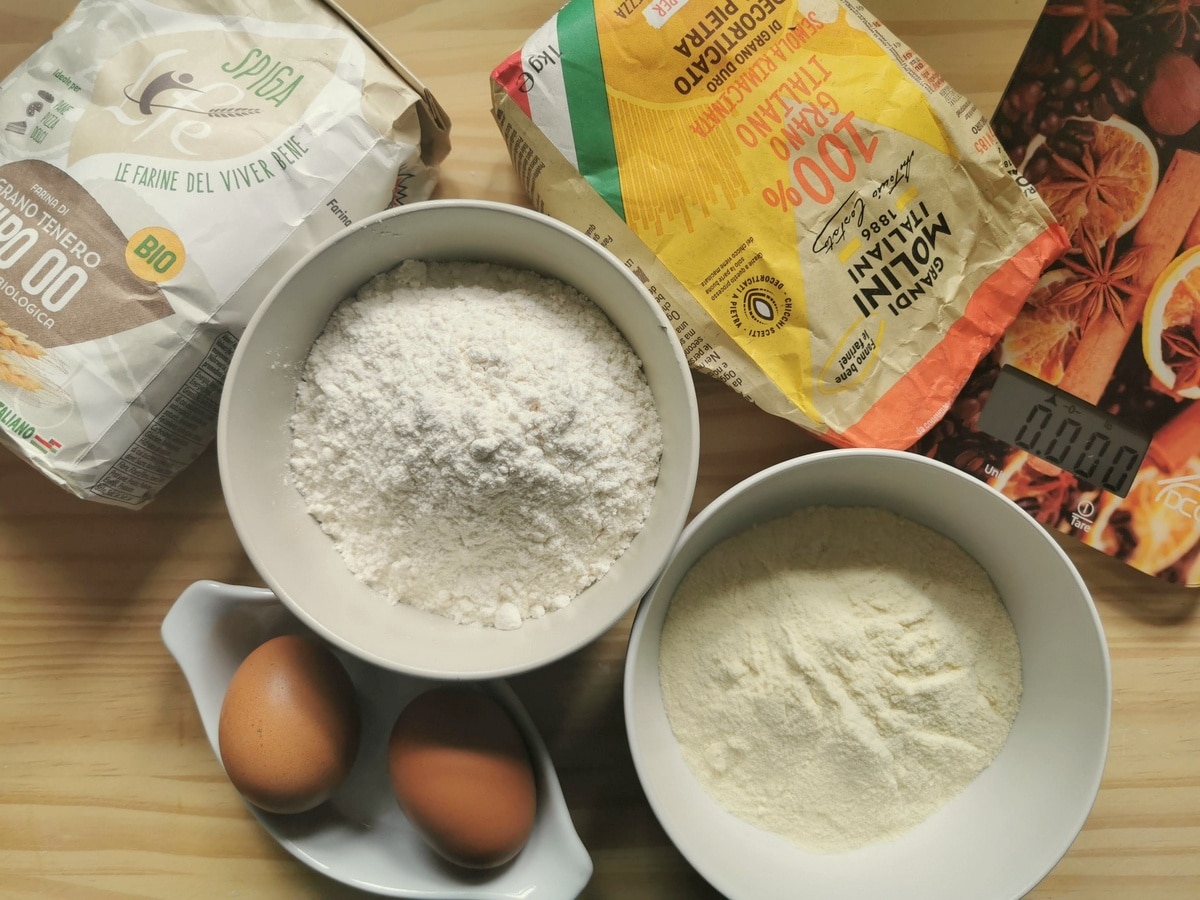
This filling is wrapped in a dough made with flour, eggs and salt although some versions call for egg yolk to replace one whole egg or water instead of one egg. I used water.
Ingredients for this casoncelli pasta.
For the dough.
Italian ‘00’ soft wheat flour: This is the finest milled soft wheat flour here in Italy. You can also use all-purpose flour. Some casoncelli recipes use only soft wheat flour.
Hard wheat semolina flour: The recipe I followed called for some hard wheat semolina flour at a ratio of 1:2. (100g semolina flour to 200 g soft wheat flour). Semolina flour is higher in gluten and helps the pasta keep its shape when cooked.
Eggs: Because there is some water in the dough, you only need 2 eggs for 300g flour. I like to use free range organic eggs.

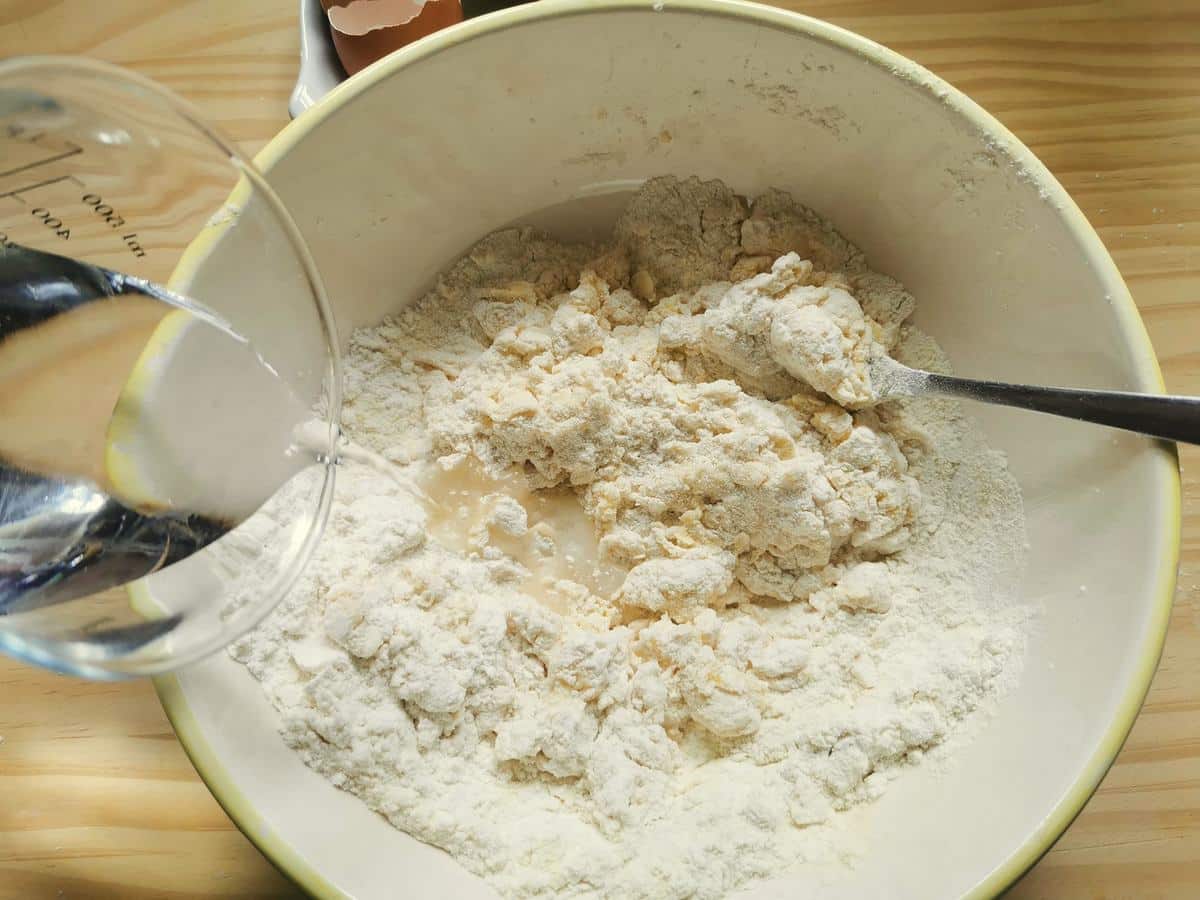
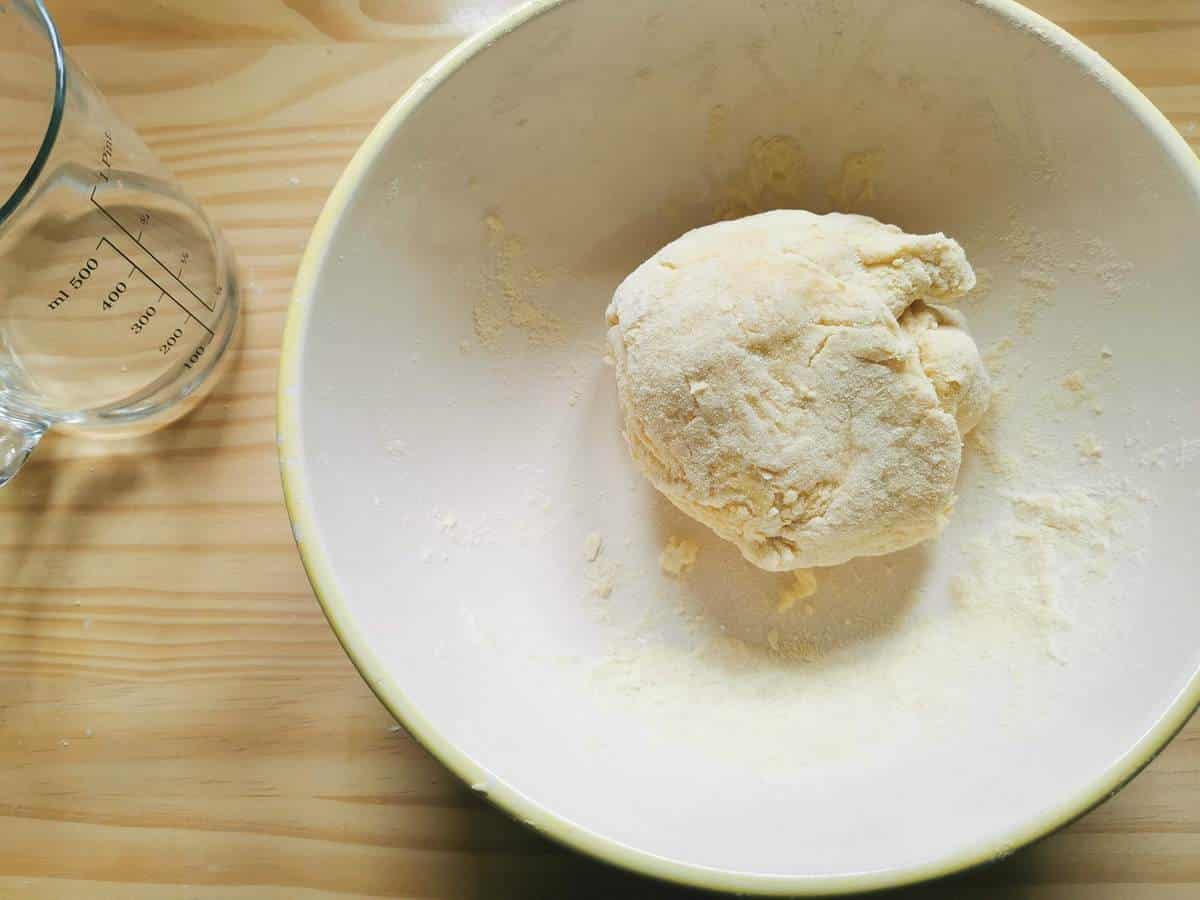
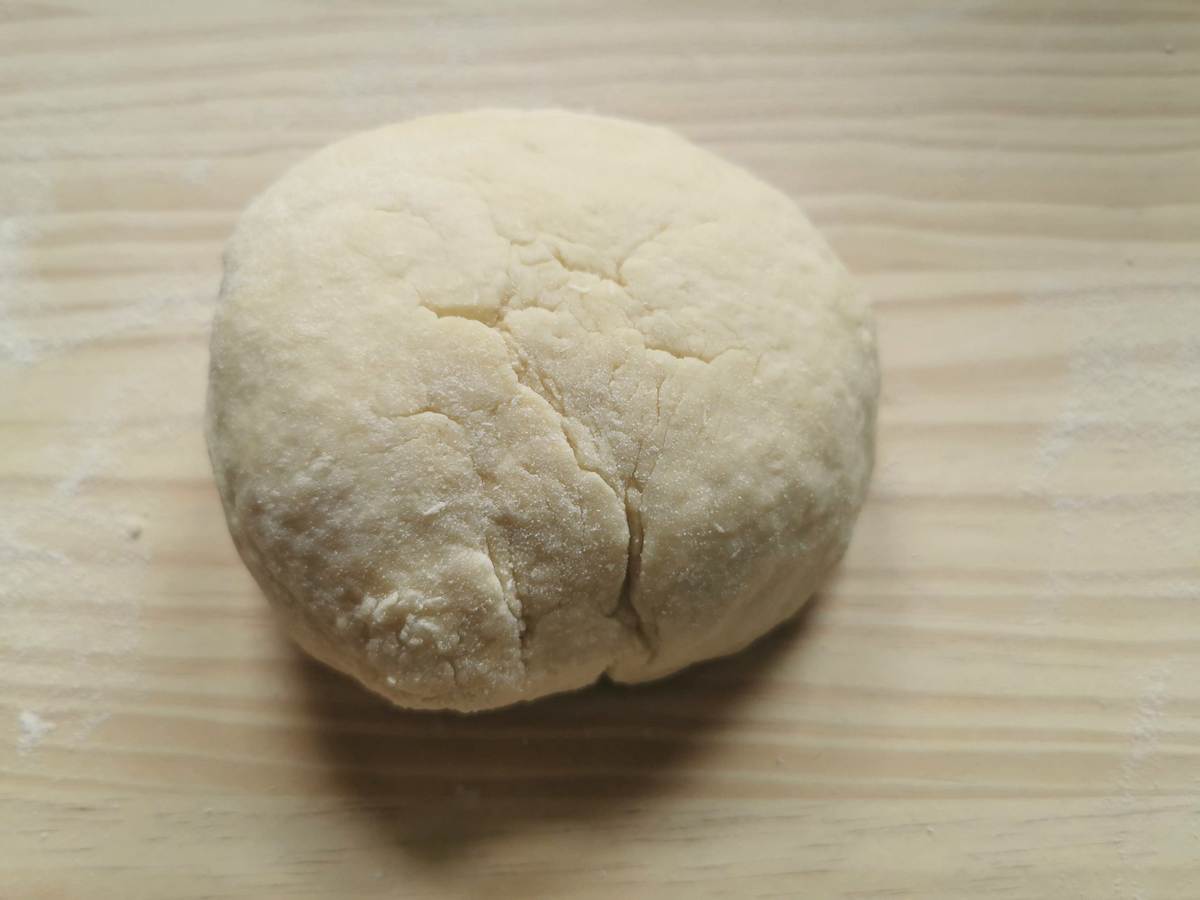
For the filling.
Potatoes: I actually used homegrown yellow potatoes for my casconcelli pasta filling. The best potatoes to use are those that are good for gnocchi too, such as Yukon Gold, Maris Piper (UK) or russet potatoes. Basically, potatoes that are floury and don’t have a lot of moisture.
Greens: Italians often use ‘erbette’ to make this type of casoncelli. This is an Italian green also known as Perpetual Spinach. It’s actually quite similar to chard, which you can use instead. I used spinach.

Italian sausage (salsiccia): You can use any plain pork sausage or one that has been flavoured with fennel. I don’t recommend garlicky or spicy sausage as this will overwhelm the other flavours in the filling.
Mortadella: mortadella or Mortadella Bologna IGP is a cured cooked pork meat sausage or luncheon meat. It’s made with finely minced high quality pork mixed with cubes of cooked pork fat. This mixture is filled into a giant casing and slow cooked for about 24 hours. Italians love mortadella but if you don’t or can’t find it, you can use your favourite Italian salami instead, just not spicy!
Breadcrumbs: I often make homemade breadcrumbs by toasting some country bread and grinding it in my food processor. You can do the same with stale bread, so you don’t have to toast it. Or use ready-made breadcrumbs.
Leeks: I love using leeks in place of onions. They add a sweet oniony flavour which is quite distinctive. Although leeks are traditional in this recipe, you can replace them with a sweet yellow onion or shallots if you prefer.
Cheese: Grana Padano is a commonly used grated cheese for pasta recipes in Lombardy because unlike Parmigiano, it is made in this region too. Grana has a milder flavour than Parmigiano. However, you can use either for your casoncelli pasta filling.
Herbs and spices: Fresh parsley is a staple ingredient in many casconcelli recipes. Here in Italy flat leaf Italian parsley is the norm. Of course, you can use curly leaf parsley instead, but it doesn’t have as much flavour as flat leaf parsley. Some recipes for casconcelli della Valcamoinca include nutmeg in the filling. I didn’t use it this time.
Butter: Italian butter is nearly always unsalted. If you use salted butter to fry the leeks, greens and parsley, don’t add more salt to the filling.
For the condiment.
Casoncelli (casonsei) are traditionally served with either just browned butter and cheese or with browned butter and sage, Italians say ‘burro e salvia’. Or with pancetta, butter and sage. I served mine with pancetta and we just loved the smoky bacon flavour it gave the dish.
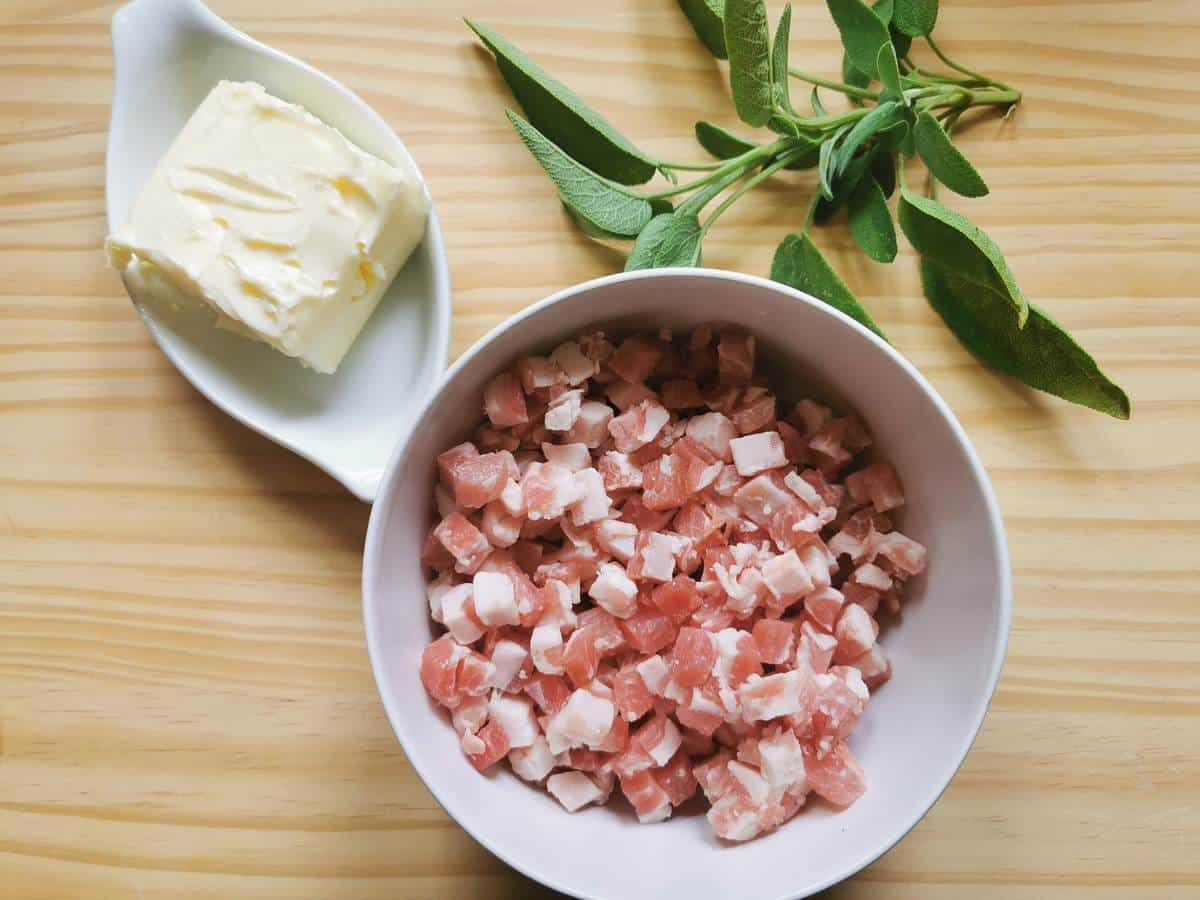
Step by step instructions.
Filling and condiment ingredient prep.
Wash the leeks, remove the outer leaves and cut them into small pieces, Remove the casing from the sausages and crumble the meat. Cut the mortadella into very small pieces. Cut the pancetta into small cubes if needed.
Wash and chop the parsley finely. Wash and cook the wet spinach until it wilts. Peel the potatoes (I don’t do this when using a potato ricer because the peel remains in the ricer when you press the cooked potato through).

Filling cooking
Cook the potatoes in boiling salted water until fork tender. Drain the spinach and squeeze out as much liquid as possible. I often use a tea towel for this. Chop the cooked spinach finely. Sauté the leeks in butter until soft, then add the spinach and parsley. Cook for another minute or two. Set aside to cool.
Pass the cooked potato through a sieve or potato ricer or mash them as well as possible without adding any liquid.
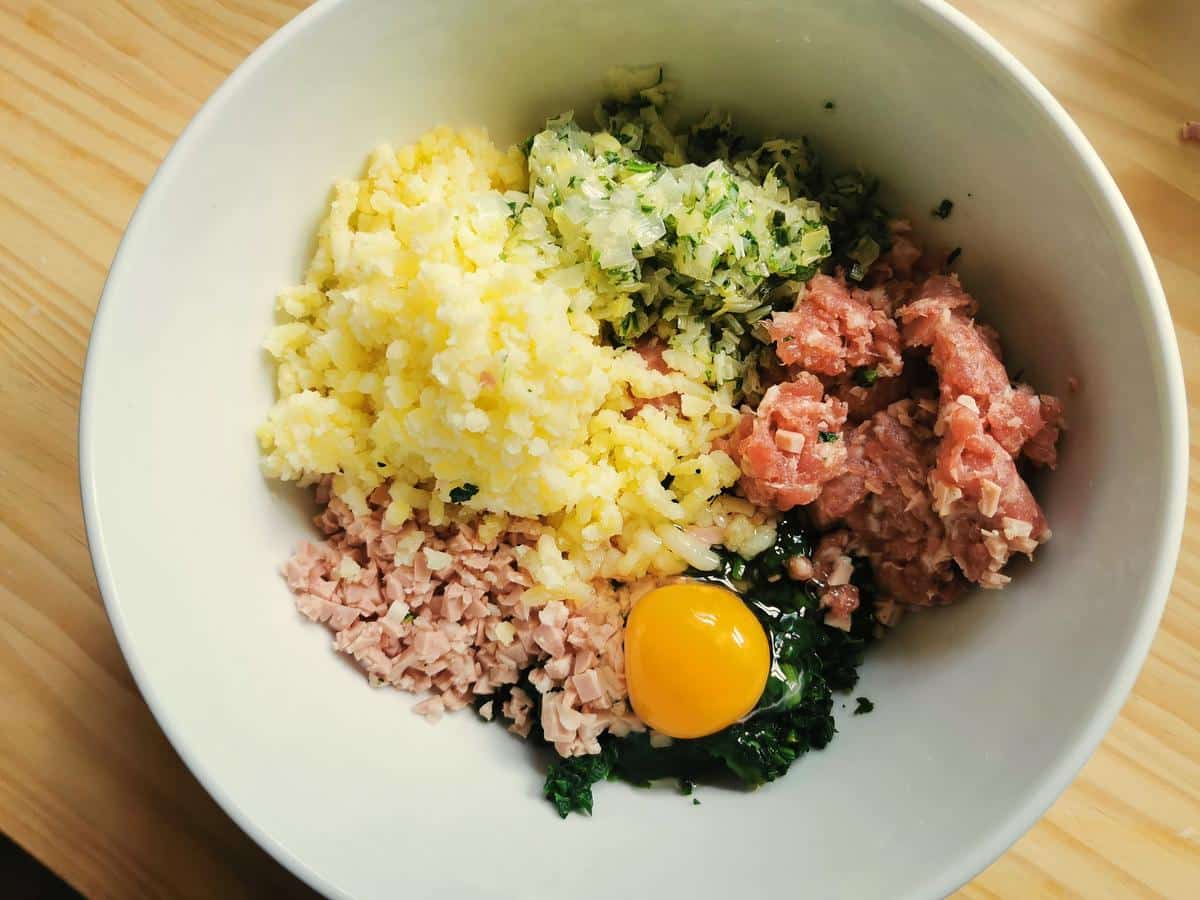
Mix filling ingredients together.
Put the breadcrumbs, grated grana, potatoes, spinach, sausage meat, finely chopped mortadella, cooked leeks, spinach and parsley, egg, salt and pepper into a bowl. Mix the ingredients well and leave the mixture to rest in the refrigerator overnight. You can also just use the filling immediately but leaving it in the fridge helps to meld the flavours and makes the filling easier to form balls with.
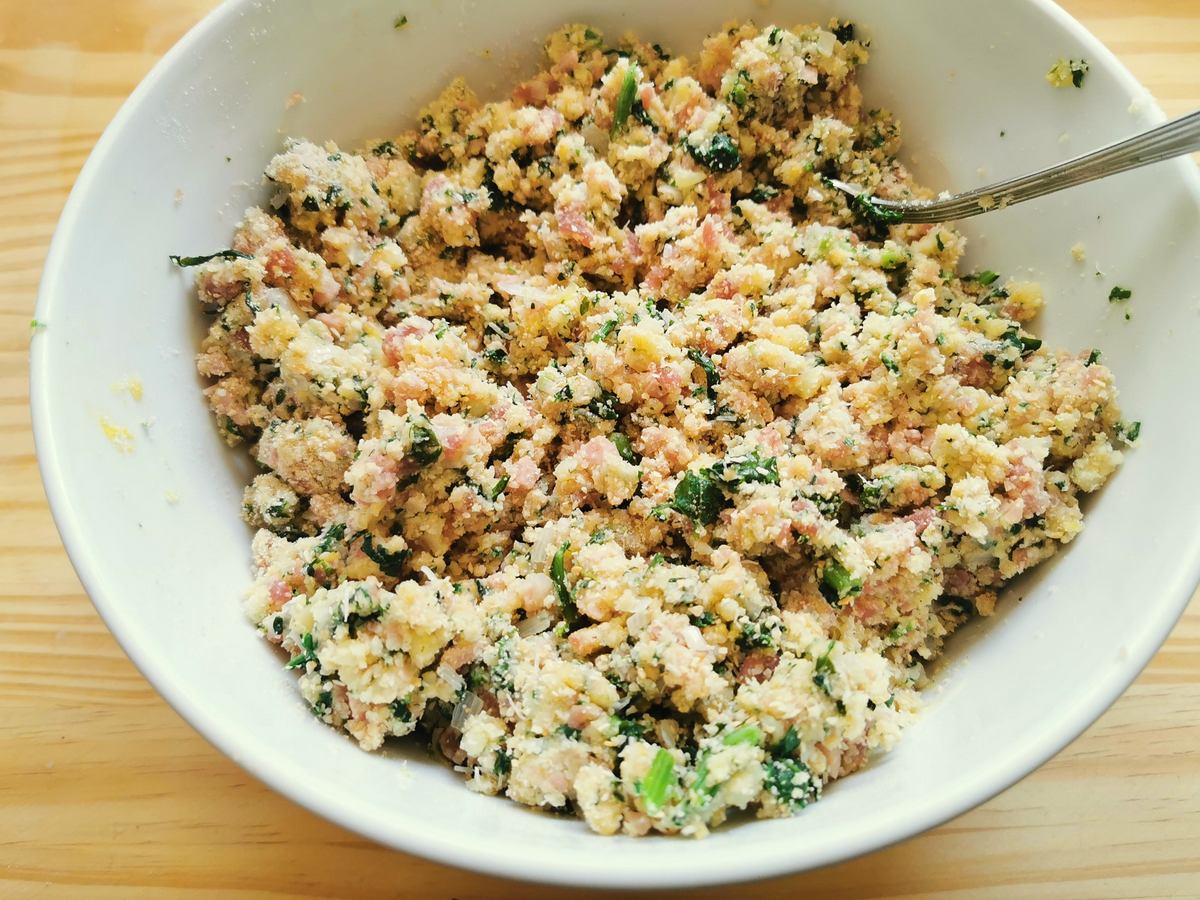
Make the dough.
Sift the ‘00’ flour and semolina flour into a bowl with a pinch of salt and 2 eggs. Start to beat the eggs with a fork and then mix everything together still using a fork. Now add water a little at a time whilst continuing to mix with a fork. Next start to knead the mixture in the bowl with your hands.
Once you have the beginnings of a dough that doesn’t stick to the sides of the bowl, turn the dough out onto a floured work surface, and continue kneading with your hands for 5-10 minutes. Roll the dough into a ball and wrap it in clingfilm (plastic wrap) and let it rest for about 30 minutes.

Make your casoncelli (casonsei).
While the dough is resting, take small pieces of filling and roll them into cherry sized balls. Place them on a flour dusted surface until ready to use them.

You may have more filling than you need. So, I would suggest rolling half into balls and start making the casoncelli. Then make more filling balls for the next batch of pasta. If you have leftover filling, it makes great patties that you can fry or bake for another meal or a snack.
Cut off about one quarter of the dough. Flatten it with the palms of your hands or a rolling pin. If using a pasta machine pass the dough through the widest setting. (That’s 7 on my machine but 1 on others)

Fold the first dough sheet into thirds and pass it again through the widest setting, shorter edge first. Do this once more. Then pass the dough through the next 2-3 settings. The sheets shouldn’t be too thin as they need to hold the filling.
Place your ready sheet on a flour dusted surface and cut out circles of about 7cm in diameter. You can use a galss for this. Remove the extra dough. You can use it to make more sheets.
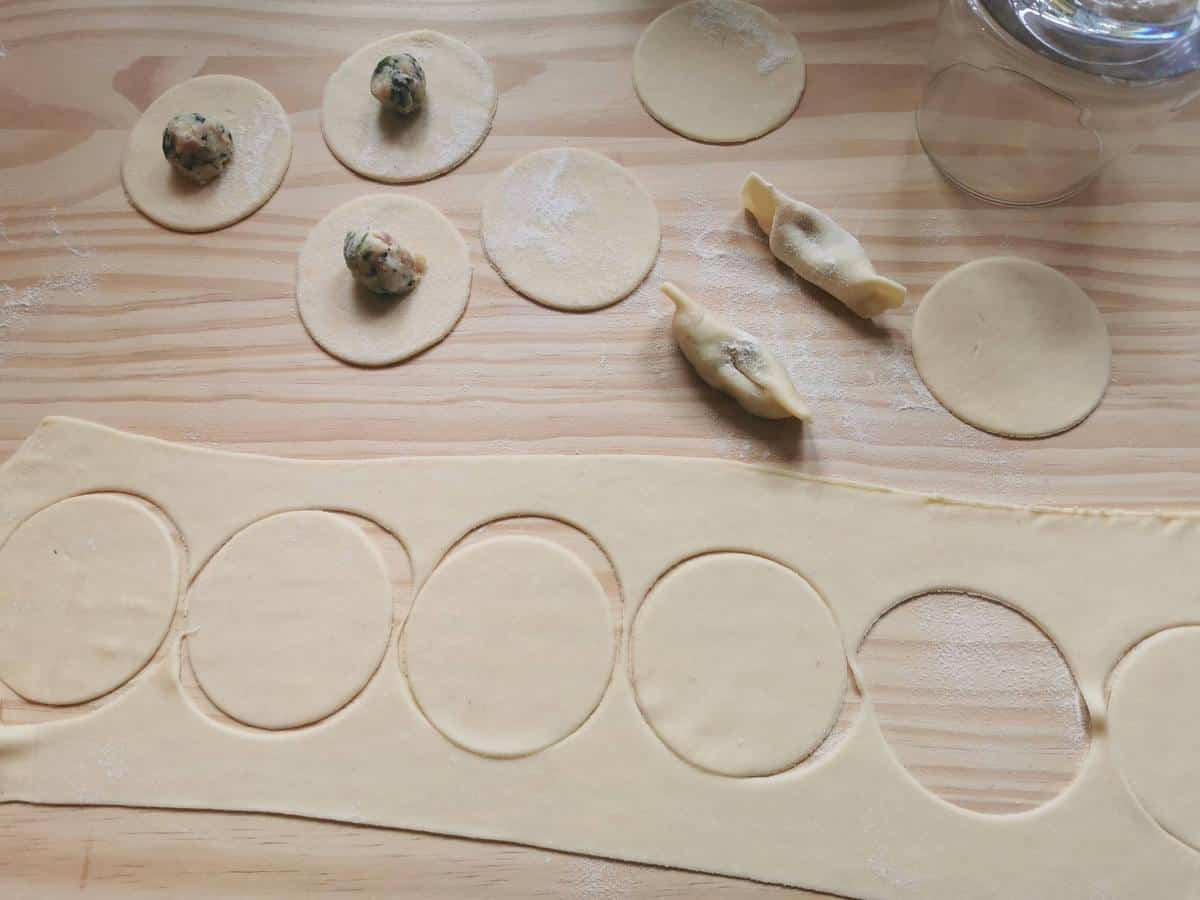
Place a ball of filling in the centre of each circle, fold the pasta over the filling to form half circles. Press the edges down with your fingers. Fold the smooth part of the stuffed pasta onto the edges so they are underneath.
Turn the pasta over and press gently in the middle where the edges of the half moon are. Next, place your ready casoncelli onto a flour dusted surface until you are ready to cook them. Continue with the rest of the dough and filling.
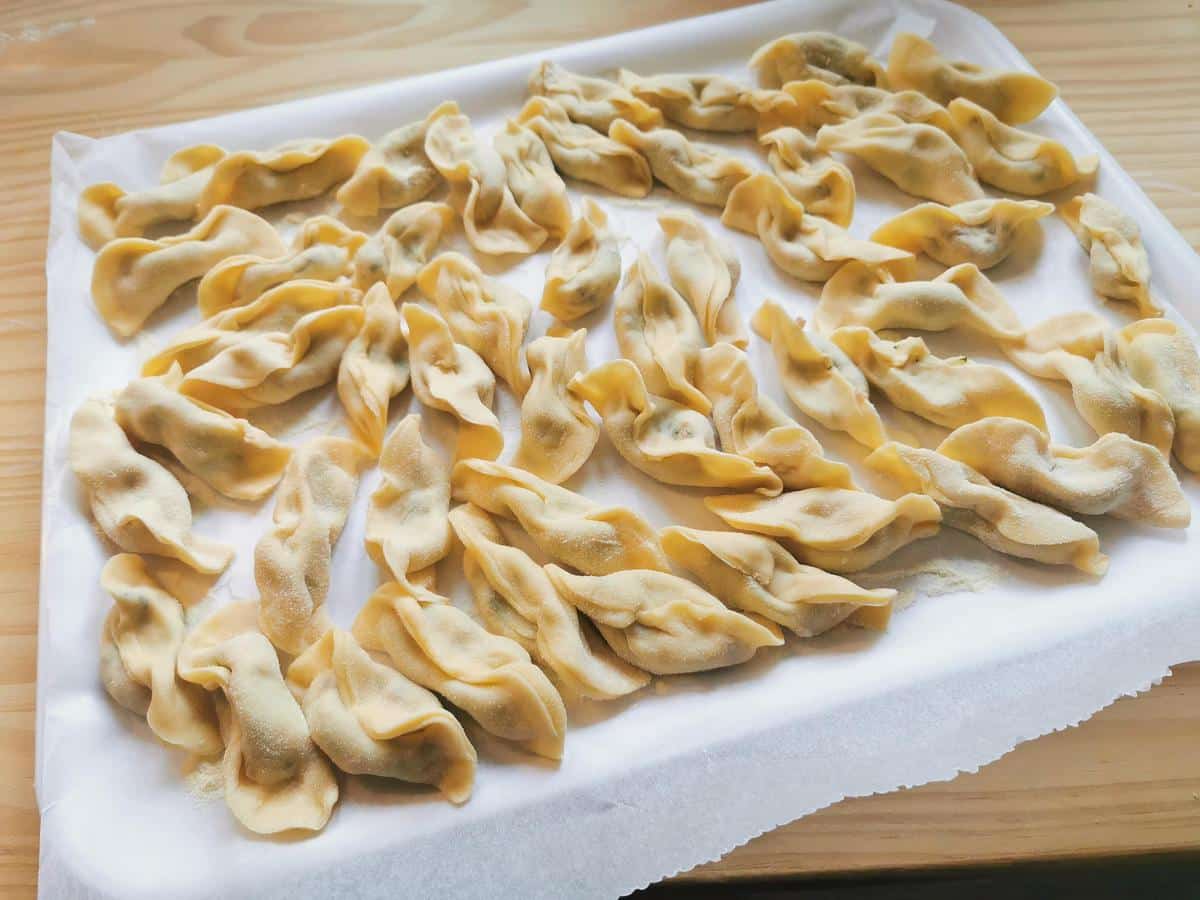
Make the condiment, cook and serve.
Put a pot of water onto boil for the pasta. In the meantime, cook the pancetta in butter until it starts to brown. Add some sage leaves and once they start to darken remove from the heat.
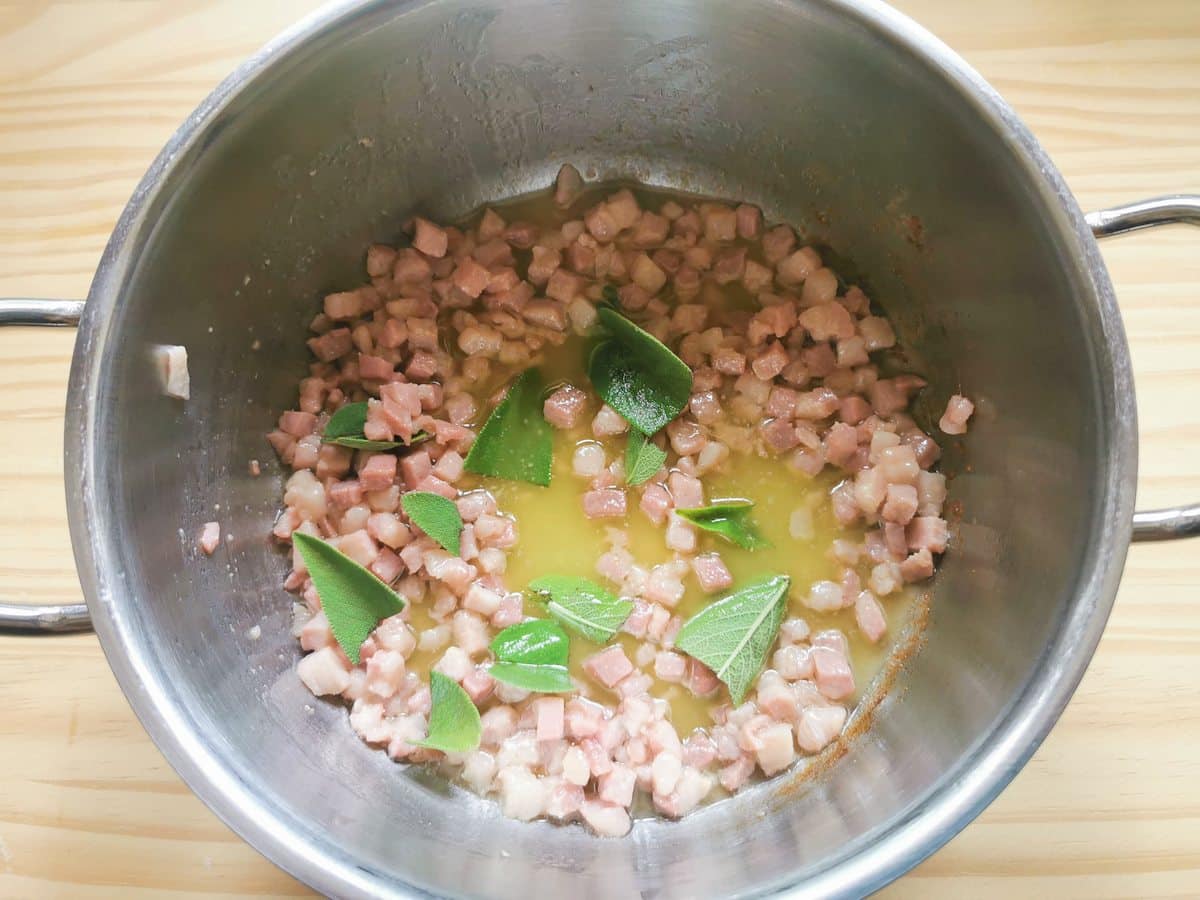
Add salt to the water for the pasta once it is boiling. Bring to a boil again and then cook the ready casoncelli in the boiling salted water. When they rise to the surface, give them another minute, test taste one casoncelli.
When it is ready, use a slotted spoon to transfer the pasta to a large pan with the condiment. Gently mix everything together over a low heat and then serve with more grated grana if required!

What to do with leftovers.
Leftover cooked casoncelli can be kept sealed in the fridge for 1-2 days. You can reheat this stuffed pasta in the microwave or fry them in butter (very good!). Leftover stuffing is delicious made into patties and fried or baked.
Uncooked casoncelli can be frozen. Place the uncooked pasta on a tray in the freezer, leaving space between them so they don’t stick together. Once frozen, you can place the pasta in a freezer bag. Cook from frozen when you want a second meal of delicious casoncelli della Valcamonica!

This fabulous stuffed pasta is definitely a labour of love. It’s not a quick weeknight meal. However, if you try it you will undertand why it’s such an iconic dish.
If you try this casoncelli recipe at home, I’d love to hear how it turns out. Write a comment here on the blog or join and post a comment and photo on my Pastaliciousness Facebook group.
Looking forward to hearing from you!
Buon appetito!
Pin for later.

Other stuffed pasta recipes to try.
- Fagottini pasta with eggplant and mozzarella.
- Heart shaped chocolate ravioli.
- Homemade fried rye flour ravioli.
- Scarpinocc di Parre.
- Ligurian potato and mint ravioli.
- Pansotti pasta with walnut sauce.
If you are interested in buying some traditional pasta making tools check out my shop page (affliate links). Plus while you’re there why not order a copy of one of my pasta recipe cookbooks? They make great prezzies for pasta lovers!
Reader Interactions


